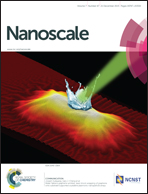Study of the nucleation and growth of antibiotic labeled Au NPs and blue luminescent Au8 quantum clusters for Hg2+ ion sensing, cellular imaging and antibacterial applications†
Abstract
Herein, we report a detailed experimental study supported by DFT calculations to understand the mechanism behind the synthesis of cefradine (CFD – an antibiotic) labeled gold nanoparticles (Au NPs) by employing CFD as both a mild reducing and capping agent. The analysis of the effect of growth conditions reveals that a higher concentration of HAuCl4 results in the formation of an increasing fraction of anisotropic structures, higher temperature leads to the formation of quasi-spherical particles instead of anisotropic ones, and larger pH leads to the formation of much smaller particles. The cyclic voltammetry (CV) results show that when the pH of the reaction medium increases from 4 to 6, the reduction potential of CFD increases which leads to the synthesis of nanoparticles (in a pH 4 reaction) to quantum clusters (in a pH 6 reaction). The MALDI-TOF mass spectrometry results of supernatant of the pH 6 reaction indicate the formation of [Au8(CFD)2S6] QCs which show fluorescence at ca. 432 nm with a Stokes shift of ca. 95 nm. The blue luminescence from Au8 QCs was applied for sensing of Hg2+ ions on the basis of an aggregation-induced fluorescence quenching mechanism and offers good selectivity and a high sensitivity with a limit of detection ca. 2 nM which is lower than the detection requirement of 10 nM by the U.S. EPA and 30 nM by WHO for drinking water. We have also applied the sensing probe to detect Hg2+ ions in bacterial samples. Further, we have investigated the antibacterial property of as-synthesized Au NPs using MIC, growth curve and cell survival assay. The results show that Au NPs could reduce the cell survival very efficiently rather than the cell growth in comparison to the antibiotic itself. The scanning electron microscopy study shows the degradation and blebbing of the bacterial cell wall upon exposure with Au NPs which was further supported by fluorescence microscopy results. These Au NPs did not show reactive oxygen species generation. We believe that the bacterial cytotoxicity is due to the direct contact of the Au NPs with bacterial cells.


 Please wait while we load your content...
Please wait while we load your content...